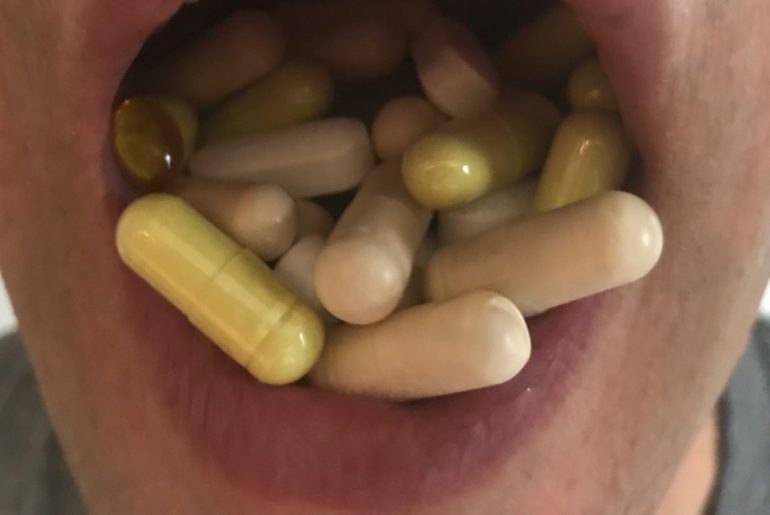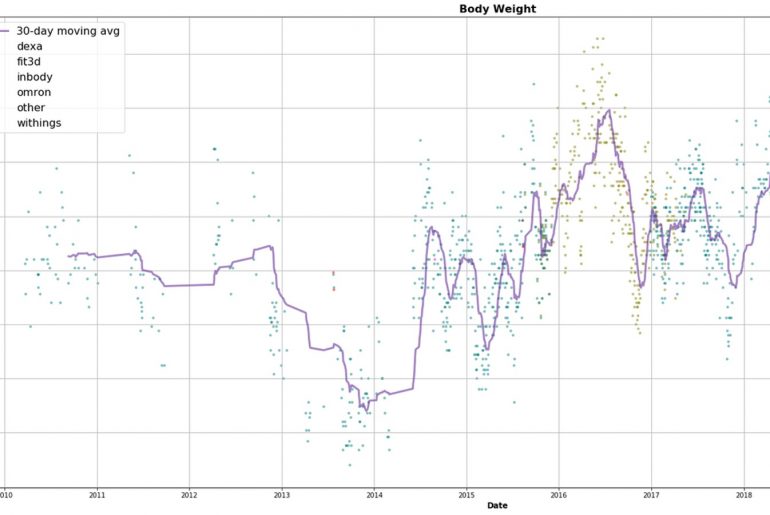Summary
• The Bulletproof diet has worked! (for me, at least). But think of it less as a “diet”, and more of a lifestyle.
• To follow the diet long-term, I made some individual refinements such as cutting back intermittent fasting, increasing carb intake or adding a “refuel” day, or avoiding certain foods until pre-existing gut/autoimmune issues have been addressed.
• Out of range markers such as high LDL cholesterol were not due to the diet – rather, the diet “exposed” other pre-existing issues such as under active thyroid and adrenals, gut issues, and chronic infections.
Background
It’s been a little over a year and a half since I decided to try out the “Bulletproof Diet“. In earlier posts (which I highly recommend skimming in order to get some background/context), I provided an overview of the Bulletproof Diet as well as recaps before and after my first 30 days:
- Bulletproof Diet and Intermittent Fasting – My First 30 Days (prior to starting)
- Bulletproof Diet and Intermittent Fasting – My 30-day Results
What is the “Bulletproof Diet”?

Taking many queues from the popular Paleo/caveman diet, the Bulletproof Diet could be called an “upgraded”/Paleo 2.0 diet. The premise is simple – eat a high (healthy!)-fat, low carb diet, getting 50-70% of calories from healthy fats, 20% from protein, and the rest from vegetables (with some fruits and starches). A major difference between Bulletproof and Paleo is the attempt to minimize toxins from the diet which are thought to play a major factor in everything from inflammation to “brain fog”.
By sticking to approved/”bulletproof” foods, you avoid/minimize eating things that can make you weak and fat, replacing them with high-quality foods that fill you up, maintain strength, and even enhance cognitive efficiency.

(Download a full version of this graphic for free here.)
Intermittent Fasting
The Bulletproof diet also incorporates intermittent fasting, whereby you consume most of your calories during a very small window, typically 6 hours and fast the remainder of the day. In other words, you would eat all of your meals between, say, 2pm and 8pm. By restricting carbohydrates, your body goes into ketosis, and starts to use fat as its primary source of energy instead of glucose. You can learn all about intermittent fasting at Leangains.com.
Note: If you have any adrenal/thyroid issues, read further down as you may want to minimize/stop intermittent fasting until those issues are resolved.
Bulletproof Coffee

A staple of the Bulletproof diet is a magical concoction called… wait for it… “Bulletproof Coffee”. In fact, most people seem to come across the coffee first, then discover the diet. You get to “cheat” intermittent fasting by having a few cups of Bulletproof coffee in the morning – a combination of high-quality, single-origin, mold-free coffee beans with grass-fed butter and coconut or MCT/XCT oil, which does wonders to stave off hunger while increasing cognitive function over the final few hours of your fast.
My 1.5-Year Results
When I originally sat down to put together this update, It was closer to being my 1-year anniversary, but I decided to hold off on posting anything until I was able to address a number of issues (thyroid/adrenals, gut/autoimmune issues) that were uncovered over time (more details to follow).
Bloodwork
Ok, so here we go – below is a summary table of key markers from blood tests that were done before during, and after my 1.5-year mark.

Cholesterol
I’ll admit that for awhile I was a little surprised that my total cholesterol and LDL numbers were not coming back down, but after seeing what others folks such as Chris Kresser had to say on the subject, my total cholesterol numbers were pretty much in line with what one would see being on a Paleo-type diet. However, notice how much my total cholesterol and LDL came down during my last blood test – I’ll talk more about this in a bit (has to do with fixing my thyroid).
While my LDL would still be considered “high” by traditional doctors, as I explained in earlier posts there are several key ratios that are more important to pay attention to – note that my ratios are even better today before I switched up my diet:

HDL to total cholesterol
In adults, the HDL “good” cholesterol/total cholesterol ratio should be higher than 0.24.
– 0.24 or higher is considered ideal (me: 0.38)
– under 0.24 – low
– less than 0.10 – very dangerous.
Triglycerides to HDL
Many doctors and researchers are finding the triglyceride/HDL ratio to be one of the better predictors of heart disease. The triglyceride/HDL “good” cholesterol ratio should be below 2. (me: 0.74)
HDL to LDL
>.3 = Good
>.4 = GREAT (me: 0.67)
LDL Particle Size
Additionally, not all LDL cholesterol is the same – there are two different types based on particle size. Large LDL particles have been shown to be safe, as they are “large and fluffy” and can pass freely through the body (and are even said to have some protective benefits). The smaller particle size LDL is what has been shown to increase risk for heart disease and heart attacks by getting clogged in arteries, leading to things like plaque buildup.
Looking at my LDL particle size analysis, I have type A – the large, “fluffy” type that does not put one at risk for things like heart disease. In fact, my risk factor for heart disease is lower than lowest risk bracket!

Testosterone

I was somewhat disappointed to see that after bumping up my testosterone levels some 25% after 30 days, it then started to go back down. Could my initial 30-day retest have been a false positive? Or were there other issues? Having an underactive thyroid has been directly linked to lower testosterone – as I began treating mine, lo and behold it shot right up!
Leaky Gut, Fat Malabsorption, and Autoimmune Issues
An early stool test revealed that I was indeed suffering from leaky gut and fat malabsorption issues. Additionally, I was completely missing certain types of gut bacteria, such as lactobacillus. My stomach pH was an acidic 5.8, which can often be an indicator of candida (my doctor at the time simply said I probably had a “candida-like” infection, but didn’t suggest any course of treatment or ask for additional tests).
Fortunately, I was introduced to a great functional medicine doctor who quickly recognized my symptoms (having had successfully treated numerous patients with similar issues) and ordered up a battery of (but very specific) blood, saliva, stool, and breath tests.

Chronic Infections

Something I had been struggling with was getting to the bottom of why my white blood cell count was always so low. We’re talking “in the red” low. After scheduling the blood, saliva, stool, and breath tests, sure enough some of the tests came back showing I had a number of lingering chronic infections, including Candida, h.pylori, Epstein-Barr virus (had mono in college), and Lyme Disease co-infection antibodies (still in my system after being bitten by a tick 10 years ago).
So essentially, my immune system was shutting down, which explains my low WBC even though I showed no outward symptoms (I never get sick) . I managed to contact a previous doctor I used some 8 years ago who still had the results of some prior blood tests and sure enough, my low WBC issues have been around for years.
h.pylori is a particularly nasty critter said to be the most common infection in the world, and it’s tricky to eradicate. Digging deeper, chronic infections such as H.Pylori can play a role in elevating one’s LDL, even when triglycerides are low.
This also puts tremendous stress on one’s body, and can ultimately wreak havoc with one’s adrenals and thyroid. Now we’re starting to peel back the layers of the onion!
Adrenals and Thyroid
I took an adrenal saliva test and at first glance, it would seem that things look pretty good, other than a slight dip below optimal range in the afternoon.

However, my cortisol to DHEA ratio was through the roof! This tipped off my doctor that my cortisol numbers could be artificially inflated due to the chronic infections. My doctor said I had what he called “functional hypothyroidism” – right at the bottom of the “normal” range. He was frankly amazed at how I was able to get by and still perform at a high level throughout the day (running a business, working out and playing sports, etc.).
Working with my doctor, I began a multi-stage program to support and return my adrenals and thyroid back to optimum levels, then go after the chronic infections (first, h.pylori and candida, then the others):
- Support thyroid and adrenals (pregnenolone, DHEA, selenium, GTA Forte II)
- Heal gut, and knock out low-hanging issues like Candida (digestive support, Ther-Biotic Complete, Ultra MFP Forte, Betaine HCL, Oil of Oregano)
- Continue strengthening immune system to go after more difficult issues like h.pylori and Lyme co-infections (reishi mushrooms, mastic gum, herbal supplements such as Byron White Formulas)
- Allow body to support itself (gradually cycle off of supplements)
I definitely plan on writing more about this in the future!
Weight and Body Fat
I really hate it when something is labeled as a “diet”, because people’s first reaction is that it’s all about losing weight when in fact it’s more of a lifestyle. I’d like to first point out that weight has never been an issue/concern of mine. That being said, even while eating anywhere from 2800-3500 calories per day, early on my weight went down by approximately 10lbs , but proceeded to stabilize, hovering between 162-165lbs.

There’s a small “blip” on the chart from last July due to using what I consider a highly unreliable hotel scale while on vacation (instead of my “go to” Withings scale). Normally I’ll just eat until I’m full/happy, but about once or twice a month I’ll do a quick “sanity check” and track the nutritional info of a day’s worth of meals just to be sure I’m staying within the parameters of the diet (total calories, percentage of calories from fat, and total carbs).
Over the past 3 months I have been working to get my weight up to 175lbs (increasing muscle mass), so as a result I have simultaneously put on a little bit of added body fat – I am considering increasing my carb intake to factor in the additional training.
Bulletproof Diet and Intermittent Fasting

I am happy to say I remained mostly “in the green” with regards to the diet, especially avoiding gluten, sugar, and grains (with the exception of some occasional white rice, which is ok), and kept my meals pretty consistent. And by consistent, yes this meant after awhile it did start to get boring. But that was my own fault due to a hectic work/life and not spending enough time researching recipes and experimenting with other ingredients. I guess I was trying to conserve willpower.
When I started, I would incorporate intermittent fasting 5-6 days/week but I had to cut it down to 1-2 days max per week as I wanted to minimize any unneeded stress put on my body while overcoming my thyroid and autoimmune issues.
Strength, Exercise, and Energy
In my original posts, I talked about the fact that I was actually over-training, and was switching to something more akin to Body by Science – short-duration, high-intensity workouts, in addition to playing soccer 2-3 times per week. I ended up doing a Crossfit on-ramp early in the year, which was right before one of my blood tests and sure enough my CRP skyrocketed!
I was then introduced to the folks at EVO Ultrafit, who are the pioneers of neurological-based strength training, built upon a foundation of what they call “iso extreme” exercises combined with a special electrical modality that literally retrains the way your brain and muscles send and receive information. I have barely lifted any free weights since I started working with them, yet I continue to gain strength and neurological efficiency.

Meals, Shopping, and Dining Out
Do your research and find quality sources for your staple ingredients like grass-fed (and grass-finished!) meats and pastured eggs like specialty butcher shops and farmers markets. There are also a number of farms that will ship meats through the mail!
Traveling on business proved to be the most difficult, but I found ways to make it work. It mainly came down to some advance planning, such as searching for gluten-free(ish) restaurants on Yelp, and when in doubt I would just go for sushi (also, any authentic Argentinian steak houses serve grass-fed steaks).
I would pack some MCT oil and a “go kit” for my coffee in my luggage (if it was a short trip, I would pre-ground it otherwise I’d pack my hand grinder along with packing a stick of grass-fed butter in a small tupperware bowl). I also figured out “hacks” for Trader Joe’s (although I avoid most items in TJ’s, they sell ground grass-fed beef and steaks in the frozen meat section and you can buy Kerrygold butter by the case at a discount if you ask) and Whole Foods.

A few key things I learned were how to use my slow cooker (nothing like coming home from work to some grass-fed shortribs!) and making my own bone broth. In the summer I would even make my own adapted version of the “Get Some” ice cream recipe (my own adapted version can be found here).
And paleo eggplant lasagna with a mixture of ground grass-fed lamb and beef is pure awesomeness! I also highly recommend you get yourself an infrared oven – they are super-inexpensive it can cook a perfectly medium rare steak in just a few minutes, with a hint of sear on the outside but without burning/oxidizing it. I also upgraded my cookware (eliminating teflon) and cooked my food at lower temperatures (for longer duration) to minimize oxidation of fats.
Supplementation and Protocols
There’s a lot of debate currently regarding supplementation and while I agree that we should try to obtain as many of our nutrients as possible from our meals, there are certain nutrients many of us simply need to add (Vitamin D and Vitamin C are good examples).

I’ve tweaked my supplementation regimen over time as my various blood markers reached optimal levels – in fact, I’ve actually reduced the number of supplements I take (stopped taking Vitamin A, for example). And while it might look like I’m still swallowing handfuls of pills, most of what I am currently taking are related to supporting my thyroid/adrenals and tackling any remaining autoimmune conditions (only a few months left on my current treatment plan!).
Skin, Teeth, Hair, Bones
For a short time after starting the diet, I began to notice some skin dryness, but it soon went away (most likely due to eating foods rich in vitamin A, such as kale). Incorporating collagen protein and bone broth into my diet has also done wonders for my skin (not to mention helping to speed up healing of bumps and bruises from playing soccer).
I’ll admit that for most of my life I took rather poor care of my teeth, and have tons of fillings to prove it. However, over the past year and a half, I have had 3 checkups (every 6 months) and have found zero cavities. In fact, during my most recent visit, after my dentist finished my cleaning he marveled at the fact that my gums did not bleed at all, and said my gums were the healthiest of any patients he’s ever seen!
A few years back I started to grow out my beard, and to my surprise there were a bunch of gray whiskers appearing at the corners of my chin! Gray hair is a natural part of aging, but there are strong ties between gray hair and thyroid disfunction (and micronutrient deficiencies such as selenium and zinc). As I began working on fixing my thyroid, lo and behold I began to notice some of the hairs regaining their pigment as they grew out!

I had a whole body DEXA Scan (Dual X-ray Absorptiometry) bone density scan performed and it showed my bone density readings to be 1.217 g/cm2 in the spine, 1.279 g/cm2 in the pelvis, 1.681 g/cm2 in the legs, and 1.293 g/cm2 in the arms, and an average of 1.391 cm2 throughout the skeleton.
This equates to a corresponding T-score (bone mineral density compared to that of a healthy 30 year-old) of 2.1, and a Z-score (bone mineral density compared to someone of same age and body size) 2.2, respectively – for reference, this is similar to what you would find in a collegiate athlete in their late teens/early 20’s.
Forget the milk – grass-fed butter… it does a body good!
What’s Next? (Adapting the Bulletproof Diet)
Like the diet itself, which is ever-evolving, I consider my journey a work in progress, making slight adaptations here and there based on my own situation and progress with the various issues I described earlier. Some general ones include:
- Coffee: I’ve decreased the amount of butter I use in my coffee and upped the levels of MCT oil (since MCT oil is easier to digest/process). I find it easier to spread my butter consumption in smaller doses throughout the day.
- Fat: When possible (which isn’t often enough), I opt for lamb over beef, because it’s easier to digest (and I definitely feel amazing after eating a big serving of it!). If you have any gut issues, ground meat is generally going to be much easier on your digestive tract.
- Intermittent Fasting/Ketosis: I cut down on my intermittent fasting from 5-6 days/week to 1 or 2 (usually on a weekend, the least stressful time of the week). I will gradually scale back up as my other conditions improve.
- Increasing Carbs: Until my thyroid issues are resolved, I’ve increased my carb intake a bit. I’ve noticed a slight bodyfat increase, but that could also be due to my increased protein intake as I continue to train and try to gain some more muscle mass.
- Protein Fasting: I consume a large amount of protein each day, and the latest version of the Bulletproof Diet suggests doing a protein fast 1 day per week (consume less than 15 grams) to trigger autophagy (allowing the body to rid itself of damaged cells), which has been shown to have tons of benefits.
Also, I will continue working through my various protocols to continue healing my gut and undoing issues that I had unknowingly been dealing with for decades.
Phew! That was a long post, but hopefully you have gotten some value out of me sharing my experience so far.






